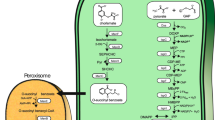Abstract
Oxylipin metabolism represents one of the important hormonal and defensive mechanisms employed by plants, algae, or animals. It begins mostly with the reaction of lipoxygenases (LOXs), which catalyze the oxygenation of polyunsaturated fatty acids to form the corresponding hydroperoxides. At present, little information about LOXs in cyanobacteria has been reported. Herein, we report the first isolation of two LOX genes (NpLOX1 and NpLOX2) from a cyanobacterium, Nostoc punctiforme ATCC29133. Incubations of recombinant NpLOX1 and NpLOX2 proteins expressed in Eschelichia coli with linoleic acid resulted in the predominant formation of linoleic acid 13-S-hydroperoxide. Other C18 and C20 fatty acids could also be substrates for NpLOX enzymes. Phylogenetic analysis of NpLOX sequences showed that the NpLOX enzymes shared a high homology with LOX sequence of a bacterial pathogen, Pseudomonas aeruginosa, and these bacterial LOXs formed a subfamily distinct from those of plants, algae, and mammals.




Similar content being viewed by others
Literature Cited
Altschul SF, Madden TL, Schaffer AA, et al. (1997) Gapped BLAST and PSI-BLAST: a new generation of protein database search programs. Nucleic Acids Res 25:3389–3402
Bachmann A, Hause B, Maucher H, et al. (2002) Jasmonate-induced lipid peroxidation in barley leaves initiated by distinct 13-LOX forms of chloroplasts. Biol Chem 383:1645–1657
Brash AR (1999) Lipoxygenases: occurrence, functions, catalysis, and acquisition of substrate. J Biol Chem 274:23679–23682
Brettar I, Christen R, Hofle MG (2002) Shewanella denitrificans sp. nov., a vigorously denitrifying bacterium isolated from the oxic-anoxic interface of the Gotland Deep in the central Baltic Sea. Int J Syst Evol Microbiol 52:2211–2217
Chain P, Lamerdin J, Larimer F, et al. (2003) Complete genome sequence of the ammonia-oxidizing bacterium and obligate chemolithoautotroph Nitrosomonas europaea. J Bacteriol 185:2759–2773
Feussner I, Wasternack C (2002) The lipoxygenase pathway. Ann Rev Plant Biol 53:275–297
Gill I, Valivety R (1997) Polyunsaturated fatty acids, Part 2: Biotransformations and biotechnological applications. Trends Biotechnol 15:470–478
Jisaka M, Boeglin WE, Kim RB, et al. (2001) Site-directed mutagenesis studies on a putative fifth iron ligand of mouse 8S-lipoxygenase: retention of catalytic activity on mutation of serine-558 to asparagine, histidine, or alanine. J Biol Chem 386:136–142
Jordan FL, Cantera JJ, Fenn ME, et al. (2005) Autotrophic ammonia-oxidizing bacteria contribute minimally to nitrification in a nitrogen-impacted forested ecosystem. Appl Environ Microbiol 71:197–206
Kessler A, Baldwin IT (2001) Defensive function of herbivore-induced plant volatile emissions in nature. Science 291:2141–2144
Koeduka T, Stumpe M, Matsui K, et al. (2003) Kinetics of barley FA hydroperoxide lyase are modulated by salts and detergents. Lipids 38:1167–1172
Liavonchanka A, Feussner I (2006) Lipoxygenases: occurrence, functions and catalysis. J Plant Physiol 163:348–357
Liu XJ, Chen F, Jiang Y (2003) Differentiation of Nostoc flagelliforme and its neighboring species using fatty-acid profiling as a chemotaxonomic tool. Curr Microbiol 47:467–474
Matui K (2006) Green leaf volatiles: hydroperoxide lyase pathway of oxylipin metabolism. Curr Opin Plant Biol 9:1–7
Matsui K, Kaji Y, Kajiwara T, et al. (1996) Developmental changes of lipoxygenase and fatty acid hydroperoxide lyase activities in cultured cells of Marchantia Polymorpha. Phytochemistry 41:177–182
Matsui K, Kajiwara T (1995) Cucumber cotyledon lipoxygenase oxygenizes trilinolein at the lipid/water interface. Lipids 30:733–738
Meeks JC, Campbell EL, Summers ML, et al. (2002) Cellular differentiation in the cyanobacterium Nostoc punctiforme. Arch Microbiol 178:395–403
Mehrabian M, Allayee H (2003) 5-lipoxygenase and atherosclerosis. Curr Opin Lipidol 14:447–457
Oldham ML, Brash AR, Newcomer ME (2005) Insights from the X-ray crystal structure of coral 8R-lipoxygenase: calcium activation via a C2-like domain and a structural basis of product chirality. J Biol Chem 280:39545–39552
Pohnert G, Boland W (2002) The oxylipin chemistry of attraction and defense in brown algae and diatoms. Nat Prod Rev 19:108–122
Rusterucci C, Montillet JL, Agnel JP, et al. (1999) Involvement of lipoxygenase-dependent production of fatty acid hydroperoxides in the development of the hypersensitive cell death induced by cryptogein on tobacco leaves. J Biol Chem 274:36446–36455
Sato N (2004) Roles of the acidic lipids sulfoquinovosyl diacylglycerol and phosphatidylglycerol in photosynthesis: their specificity and evolution. J Plant Res 6:495–505
Schneider C, Tallman KA, Porter NA, et al. (2001) Two distinct pathways of formation of 4-hydroxynonenal. Mechanisms of nonenzymatic transformation of the 9- and 13-hydroperoxides of linoleic acid to 4-hydroxyalkenals. J Biol Chem 276:20831–20838
Serrano-Mollar A, Closa D (2005) Arachidonic acid signaling in pathogenesis of allergy: therapeutic implications. Curr Drug Targets Inflamm Allergy 4:151–155
Vance RE, Hong S, Gronert K, et al. (2004) The opportunistic pathogen Pseudomonas aeruginosa carries a secretable arachidonate 15-lipoxygenase. Proc Natl Acad Sci USA 101:2135–2139
Vidal-Mas J, Busquets M, Manresa A (2005) Cloning and expression of a lipoxygenase from Pseudomonas aeruginosa 42A2. Antonie Van Leeuwenhoek 87:245–251
Vollack KU, Xie J, Hartig E, et al. (1998) Localization of denitrification genes on the chromosomal map of Pseudomonas aeruginosa. Microbiology 144:441–418
Yamamoto S (1992) Mammalian lipoxygenases: molecular structures and functions. Biochim Biophys Acta 1128:117–131
Acknowledgments
The authors thank Dr. Hiroshi Kato, Mie University, Japan, for providing us with the Nostoc punctiforme ATCC29133 strain and experimental advice on the bacterial culture. This work was partly supported by the JSPS-NRCT Scientific Cooperation Program under the Core University Program on Microbial Resources.
Author information
Authors and Affiliations
Corresponding author
Rights and permissions
About this article
Cite this article
Koeduka, T., Kajiwara, T. & Matsui, K. Cloning of Lipoxygenase Genes from a Cyanobacterium, Nostoc punctiforme, and Its Expression in Eschelichia coli . Curr Microbiol 54, 315–319 (2007). https://doi.org/10.1007/s00284-006-0512-9
Received:
Accepted:
Published:
Issue Date:
DOI: https://doi.org/10.1007/s00284-006-0512-9




